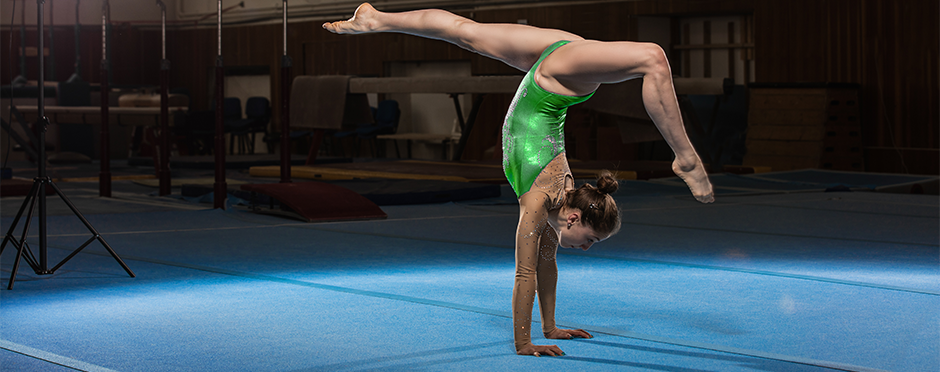
Hip Impingement In Gymnasts
Leave a CommentGymnasts require a lot of hip mobility to perform their amazing skills. These advanced and dynamic skills can lead to pain in the hip joint that is more than just muscle soreness. Both male and female gymnasts can suffer from hip pain. One common hip condition is hip impingement, and we will discuss what that is as well as important details for gymnasts with hip pain.
What Is Hip Impingement?
The hip joint is a ball and socket joint between the head of the femur (ball) and the acetabulum of the pelvis (socket). Due to the type of joint, the hip can move in many different directions. There are many muscles and ligaments surrounding the hip joint. Hip impingement occurs when the head of the femur pinches up against the socket; this is also known as femoralacetabular impingement (FAI). The pinching occurs due to abnormal bone growth on either the head of the femur or within the socket. When this happens, damage can occur to the labrum, which is the cartilage surrounding the acetabulum. This damage can cause stiffness and pain in the hip which can limit the activities you can do.
Symptoms Of FAI:
- Pain or ache in the inner hip or groin region
- Pain worse with activity or with prolonged sitting
- Limping
- Stiffness in the hip (difficulty putting on socks or shoes)
- Low back pain or pain in the sacroiliac joint on the back of the pelvis
- Possible locking, clicking, or catching sensation within the joint
How Is FAI Diagnosed?
FAI is due to bone abnormalities, so it is something you are born with, not due to an injury. However, FAI may become symptomatic earlier in gymnasts due to the higher demands on the hip joint1. This impingement can lead to damage to the labrum of the hip which can cause more pain symptoms.
Impingement tests can be performed to reproduce the pain from FAI. However, an X-ray or MRI will help identify the bone changes and any damage within the hip joint or the labrum.
Conservative Treatment For FAI
Conservative treatment for FAI is non-surgical management of symptoms. One option is steroid injections, which can help reduce inflammation in and around the hip joint. The other conservative treatment is rest and physical therapy. Limiting activity can reduce the friction in the joint. Physical therapy will help address muscle imbalances in the hip and surrounding joints to improve mobility and function. Conservative treatment is the recommended first approach for FAI before surgical considerations.
Surgical Treatment For FAI
If conservative treatment does not improve the symptoms, surgery is the next option. Most often, surgery for FAI is performed arthroscopically. The damaged bone or cartilage is removed to allow the hip joint to move fully without pinching. The labrum can also be repaired if there is damage to that structure. Physical therapy is performed after surgery per the surgeon’s recommendations. Surgical recovery is a lengthy process.
Returning To Gymnastics With FAI
Gymnasts with hip pain face a greater challenge for treatment1 due to the intense nature of their sport and high flexibility. Whether conservative or surgical management, here is an objective return to play progression that gymnasts would follow:
- Pain-free walking
- Full, pain-free hip range of motion
- Progression in stretching to perform splits pain-free bilaterally
- Return to low-level tumbling skills with low impact- cartwheel, handstand, back walkover
- Begin progression on bars- no dismounts
- Begin working on leaps
- Begin work on the tumble track
- Begin working dismounts into the pit
- Gradual return to tumbling passes with more impact and twisting
FAI can affect both male and female gymnasts. Diagnosing and recovering from FAI can be a lengthy process, but with teamwork from the athlete, medical team, physical therapist, and coaches, gymnasts can return to their sport.
If you or your athlete are experiencing pain, do not wait. Schedule a free assessment at an Athletico near you.
Athletico provides rehabilitation to gymnasts of all levels and abilities. We have physical therapists involved with our Gymnastics and Cheerleading Program who understand the sport’s demands to address the athlete’s physical needs. Free assessments are available in-clinic and virtually through our telehealth platform.
*Per federal guidelines, beneficiaries of plans such as Medicare, Medicaid, Tricare, VHA and other federally funded plans are not eligible for free assessments.
The Athletico blog is an educational resource written by Athletico employees. Athletico bloggers are licensed professionals who abide by the code of ethics outlined by their respective professional associations. The content published in blog posts represents the opinion of the individual author based on their expertise and experience. The content provided in this blog is for informational purposes only, does not constitute medical advice and should not be relied on for making personal health decisions.
References:
1. Weber AE, Bedi A, Tibor LM, Zaltz I, Larson CM. The Hyperflexible Hip: Managing Hip Pain in the Dancer and Gymnast. Sports Health. 2015 Jul;7(4):346-58. doi: 10.1177/1941738114532431. PMID: 26137181; PMCID: PMC4481673.
2. Safran MR, Foard SJ, Robell K, Pullen WM. Incidence of Symptomatic Femoroacetabular Impingement: A 4-Year Study at a National Collegiate Athletic Association Division I Institution. Orthop J Sports Med. 2022 Apr 12;10(4):23259671221084979. doi: 10.1177/23259671221084979. PMID: 35434170; PMCID: PMC9008859.
